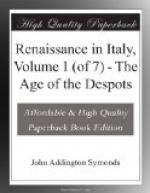CHAPTER IV.
THE REPUBLICS.
The different Physiognomies of the Italian Republics—The Similarity of their Character as Municipalities—The Rights of Citizenship—Causes of Disturbance in the Commonwealths—Belief in the Plasticity of Constitutions—Example of Genoa—Savonarola’s Constitution—Machiavelli’s Discourse to Leo X.—Complexity of Interests and Factions—Example of Siena—Small Size of Italian Cities—Mutual Mistrust and Jealousy of the Commonwealths—The notable Exception of Venice—Constitution of Venice—Her wise System of Government—Contrast of Florentine Vicissitudes—The Magistracies of Florence—Balia and Parlamento—The Arts of the Medici—Comparison of Venice and Florence in respect to Intellectual Activity and Mobility—Parallels between Greece and Italy—Essential Differences—The Mercantile Character of Italian Burghs—The ’Trattato del Governo della Famiglia’—The Bourgeois Tone of Florence, and the Ideal of a Burgher—Mercenary Arms.
The despotisms of Italy present the spectacle of states founded upon force, controlled and molded by the will of princes, whose object in each case has been to maintain usurped power by means of mercenary arms and to deprive the people of political activity. Thus the Italian principalities, however they may differ in their origin, the character of their administration, or their relation to Church and Empire, all tend to one type. The egotism of the despot, conscious of his selfish aims and deliberate in their execution, formed the motive principle in all alike.
The republics on the contrary are distinguished by strongly marked characteristics. The history of each is the history of the development of certain specific qualities, which modified the type of municipal organization common to them all. Their differences consist chiefly in the varying forms which institutions of a radically similar design assumed, and also in those peculiar local conditions which made the Venetians Levant merchants, the Perugians captains of adventure, the Genoese admirals and pirates, the Florentines bankers, and so forth. Each commonwealth contracted a certain physiognomy through the prolonged action of external circumstances and by the maintenance of some political predilection. Thus Siena, excluded from maritime commerce by its situation, remained, broadly speaking, faithful to the Ghibelline party; while Perugia at the distance of a few miles, equally




